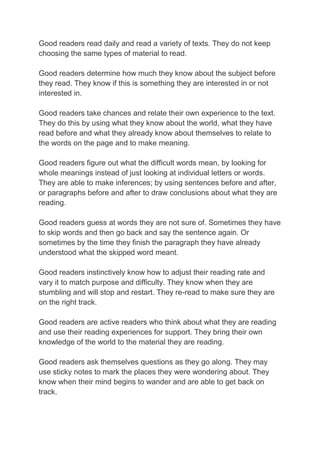
Good readers
- 1. Good readers read daily and read a variety of texts. They do not keep choosing the same types of material to read. Good readers determine how much they know about the subject before they read. They know if this is something they are interested in or not interested in. Good readers take chances and relate their own experience to the text. They do this by using what they know about the world, what they have read before and what they already know about themselves to relate to the words on the page and to make meaning. Good readers figure out what the difficult words mean, by looking for whole meanings instead of just looking at individual letters or words. They are able to make inferences; by using sentences before and after, or paragraphs before and after to draw conclusions about what they are reading. Good readers guess at words they are not sure of. Sometimes they have to skip words and then go back and say the sentence again. Or sometimes by the time they finish the paragraph they have already understood what the skipped word meant. Good readers instinctively know how to adjust their reading rate and vary it to match purpose and difficulty. They know when they are stumbling and will stop and restart. They re-read to make sure they are on the right track. Good readers are active readers who think about what they are reading and use their reading experiences for support. They bring their own knowledge of the world to the material they are reading. Good readers ask themselves questions as they go along. They may use sticky notes to mark the places they were wondering about. They know when their mind begins to wander and are able to get back on track.
- 2. Good readers create mental pictures as they read descriptive passages. They visualize and create mental pictures as they read. Good readers expect the material to get easier and read on, using the context to make sense or help them make meaning of what they read. Good readers know how to use pictures, graphs, marginal notes, bold words, titles and other text supports on the page to figure out the meaning of the difficult or long passages they are trying to read. Good readers try not to read too slowly and are able to change their approaches for special materials depending on the purpose of their reading. They understand that they read the newspaper differently than a non-fiction selection. Good readers know reading for meaning is a process that requires active participation from the reader- whether when reading for pleasure, to complete an assignment, or to find information to help with questions they may have. Good readers recognize when what they read is difficult; they identify parts of the text that confuse them. They use I'M Stuck-fix-up strategies such as rereading, changing their reading rate, or go for a dictionary. They work to correct the difficulty. They don't just give up. Good readers know if they liked what they have just read, why or why not it appealed to them, and whether or not they would recommend it to anyone else. Good readers use story details to support their opinion. Good readers use Comprehension Strategies to draw conclusions, analyze, synthesize, and to compare and contrast. (Bloom's Taxonomy) They may use strategies such as predicting, summarizing, questioning the text, and questioning author's purpose in order to make sense of what they read.
